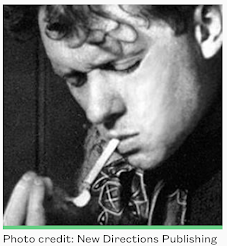He’s so unhip that when you say ‘Dylan’, he thinks you’re talking about Dylan Thomas, whoever he was. The man ain’t got no culture.
—Simon and Garfunkel
“A Simple Desultory Philippic (Or How I Was Robert McNamara’d Into Submission)”
While “Rhymin’ Simon” was likely referencing British poet Dylan Thomas with a tongue-in-cheek approach, the snarky aside nevertheless addressed a cultural divide between the Sixties counterculture and their literary forbearers in the previous era.
Thomas, born in Swansea, Wales in 1914, became an early admirer of the work of Yeats and Poe and soon ascended to national attention himself while still in his youth. He would eventually garner world acclaim as one of the premiere poets of the English-speaking world, broadcasting for the BBC as a means of supporting himself and later recording his own works for a series of record albums in the U.S.
In 1934 he published his first book 18 Poems during which time his work took on its characteristic style highlighting romantic imagery and aesthetic rhythmic style. The “images” he created, particularly ripe with conflict and contradiction, were evident in his best known work including “And death shall have no dominion” and “Do not go gentle into that good night.”
After working on a number of screenplays and several tours of America, Thomas passed away in 1953. His hard-drinking ‘Dionysian’ image which fell him has since influenced everyone from Charles Bukowski to Jim Morrison of the Doors.
Like many of my own generation, my primary reference point regarding Thomas would (regrettably) be the recitation of his most renowned work by Rodney Dangerfield in the hit movie, Back to School where the comedy legend learns the poem to get through a mandatory exam. That should be satisfactory enough for most, however, considering the Minnesota folk-rocker who adopted Thomas’s name and rode it to stardom himself apparently didn’t even know how it was pronounced at first.
That all goes to show that the cyclical nature of art and communication for that matter can be irrelevant in its details. The proliferation of what we experience through words, images, juxtapositions and patterns are what we pass on and remember— when all is said and done.
Love to hear from you.
Use the contact form on the right!






